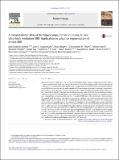A computational atlas of the hippocampal formation using ex vivo, ultra-high resolution MRI: Application to adaptive segmentation of in vivo MRI
Author(s)
Iglesias, Juan Eugenio; Augustinack, Jean C.; Nguyen, Khoa; Player, Christopher M.; Player, Allison; Wright, Michelle; Roy, Nicole; Frosch, Matthew P.; McKee, Ann C.; Wald, Lawrence L.; Fischl, Bruce; Van Leemput, Koen; ... Show more Show less
DownloadRoy_A computational.pdf (3.555Mb)
PUBLISHER_CC
Publisher with Creative Commons License
Creative Commons Attribution
Terms of use
Metadata
Show full item recordAbstract
Automated analysis of MRI data of the subregions of the hippocampus requires computational atlases built at a higher resolution than those that are typically used in current neuroimaging studies. Here we describe the construction of a statistical atlas of the hippocampal formation at the subregion level using ultra-high resolution, ex vivo MRI. Fifteen autopsy samples were scanned at 0.13 mm isotropic resolution (on average) using customized hardware. The images were manually segmented into 13 different hippocampal substructures using a protocol specifically designed for this study; precise delineations were made possible by the extraordinary resolution of the scans. In addition to the subregions, manual annotations for neighboring structures (e.g., amygdala, cortex) were obtained from a separate dataset of in vivo, T1-weighted MRI scans of the whole brain (1 mm resolution). The manual labels from the in vivo and ex vivo data were combined into a single computational atlas of the hippocampal formation with a novel atlas building algorithm based on Bayesian inference. The resulting atlas can be used to automatically segment the hippocampal subregions in structural MRI images, using an algorithm that can analyze multimodal data and adapt to variations in MRI contrast due to differences in acquisition hardware or pulse sequences. The applicability of the atlas, which we are releasing as part of FreeSurfer (version 6.0), is demonstrated with experiments on three different publicly available datasets with different types of MRI contrast. The results show that the atlas and companion segmentation method: 1) can segment T1 and T2 images, as well as their combination, 2) replicate findings on mild cognitive impairment based on high-resolution T2 data, and 3) can discriminate between Alzheimer's disease subjects and elderly controls with 88% accuracy in standard resolution (1 mm) T1 data, significantly outperforming the atlas in FreeSurfer version 5.3 (86% accuracy) and classification based on whole hippocampal volume (82% accuracy).
Date issued
2015-04Department
Massachusetts Institute of Technology. Computer Science and Artificial Intelligence LaboratoryJournal
NeuroImage
Publisher
Elsevier
Citation
Iglesias, Juan Eugenio; Augustinack, Jean C.; Nguyen, Khoa; Player, Christopher M.; Player, Allison; Wright, Michelle; Roy, Nicole; et al. “A Computational Atlas of the Hippocampal Formation Using Ex Vivo, Ultra-High Resolution MRI: Application to Adaptive Segmentation of in Vivo MRI.” NeuroImage 115 (July 2015): 117–137. © 2015 The Authors
Version: Final published version
ISSN
1053-8119